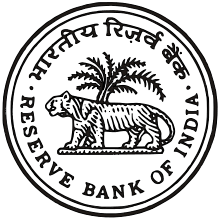Reserve Bank of India, South Zonal Office
|
RBI seal | |
| Headquarters | Chennai, Tamil Nadu |
|---|---|
| Established | 1 April 1935 |
| Regional Director, Tamil Nadu | Dr. J. Sadakkadulla |
| Currency |
Indian rupee (₹) INR (ISO 4217) |
| Reserves | US$302.10 billion (US$302.1 billion)[1][Note 1] |
| Bank rate | 8.00% |
| Interest on reserves | 6.00% |
| Website | http://www.rbi.org.in/regionalbranch/chennai/chennai.aspx |
The Reserve Bank of India in Chennai is one of the four zonal representations of the Reserve Bank of India, the central bank of India, the other three being located in New Delhi, Mumbai, and Kolkata. The central office of the Reserve Bank is located in Mumbai. The Chennai office serves the southern region of the country. It is also the office of the regional director of the bank for the Indian state of Tamil Nadu, along with 19 other regional offices across the country. The Chennai zonal office is located in Fort Glacis on Rajaji Salai. The Chennai office also represents the local board for the southern region of India headed by a director and is also one of the four zonal training centres of the bank. The Reserve Bank Staff College is located at Anna Salai, Teynampet, which is one of the two colleges of the bank, the other one located in Pune.[2]
History

The Reserve Bank of India was established on the basis of the recommendations of the Hilton Young Commission.[3] The bank commenced operations on 1 April 1935. The bank was established in accordance with the provisions of the Reserve Bank of India Act, 1934 (II of 1934).[4][5] The bank began its operations by taking over from the government the functions so far being performed by the Controller of Currency and from the Imperial Bank of India, the management of government accounts and public debt. The Central Office of the Reserve Bank, where the governor sits and where policies are formulated, was initially established in Calcutta but was permanently moved to Mumbai in 1937. The existing currency offices at Calcutta, Bombay, Madras, Rangoon, Karachi, Lahore and Cawnpore (Kanpur) became branches of the Issue Department. Offices of the Banking Department were established in Calcutta, Bombay, Madras, Delhi and Rangoon. Burma (Myanmar) seceded from the Indian Union in 1937 but the Reserve Bank continued to act as the Central Bank for Burma till Japanese Occupation of Burma and later up to April, 1947. After the partition of India, the Reserve Bank served as the central bank of Pakistan up to June 1948 when the State Bank of Pakistan commenced operations. The bank, which was originally a shareholder's bank, was nationalised in 1949 and is fully owned by the Government of India since then.[6]
The Central Bank in the city was opened in 1935 and was operated from a rented premises of the State Bank of India office building located at Parry's Corner. The present building was constructed in the 1960s by Tarapore Company.[7]
See also
Notes
References
- 1 2 Press Trust of India (25 December 2011). "India's forex reserves slump by $4.67 billion". Mumbai: New Delhi Television Limited. Retrieved 2 January 2012.
- ↑ "About Us". Reserve Bank of India. Retrieved 4 September 2012.
- ↑ "Reserve Bank of India: Platinum Jubilee (PDF)" (pdf). RBI.org.in. 2010. Retrieved 15 April 2012.
- ↑ "Reserve Bank of India Act, 1934" (PDF). p. 115. Retrieved 6 August 2012.
- ↑ "RESERVE BANK OF INDIA ACT, 1934 (As modified up to 28 February 2009)" (PDF). Reserve Bank of India (RBI). Retrieved 20 November 2010.
- ↑ "Brief History". Reserve Bank of India. Retrieved 4 September 2012.
- ↑ Srikanth, R. (13 May 2012). "Rajaji Salai, the seat of power". The Hindu. Chennai: The Hindu. Retrieved 19 May 2013.
External links
- Homepage of the Regional office of the Reserve Bank of India, Chennai
- Reserve Bank of India Ombudsman site
| |||||||||||||||||||||||||
| |||||||||||||||||||||||||
| |||||||||||||||||||||||||
| |||||||||||||||||||||||||
Names in italics indicate non-sovereign (dependent) territories, former countries, or states with limited recognition | |||||||||||||||||||||||||
| Reserve bank | |
|---|---|
| Public sector banks |
|
| Private sector banks |
|
| Cooperative banks | |
| Foreign banks |
|
| Regional Rural Banks |
|
| Interbank networks | |
| Defunct banks |
|
| Related topics |
|
| Companies |
|
|---|---|
| Governance |
|
| Currency | |
| Financial services | |
| History | |
| People |
|
| States | |
| Sectors | |
| |
Coordinates: 13°05′04″N 80°17′19″E / 13.084387°N 80.288563°E / 13.084387; 80.288563
